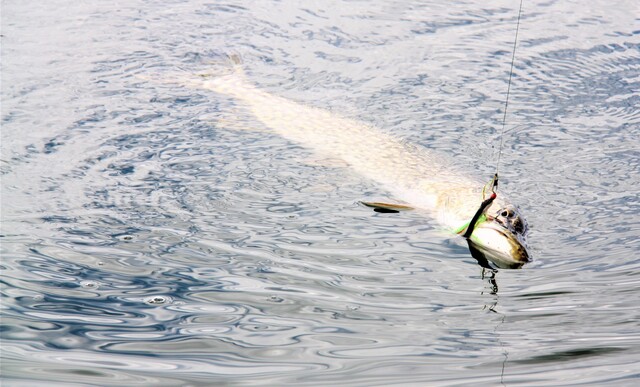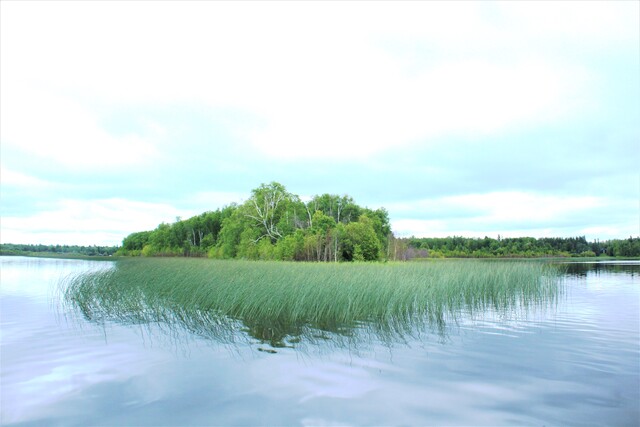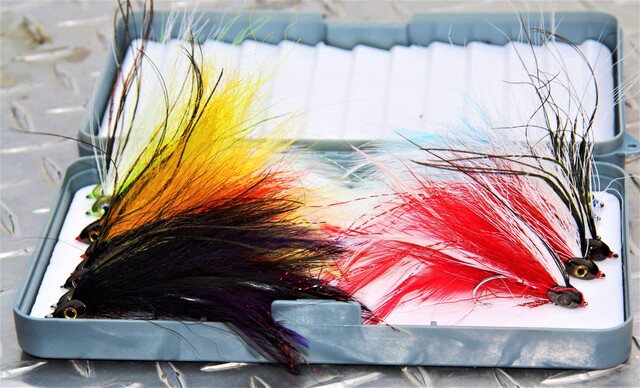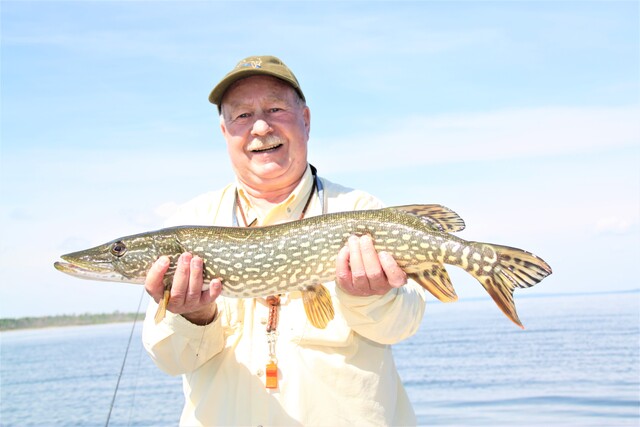In the pecking order of prairie fishes, the general consensus is that the walleye if our king of the waters. Maybe more because of Old Walter’s eating qualities than his sporting abilities. Beauty contests are always subject to debate and controversy. But it hard not to agree that pike are our most versatile fish - inhabiting thousands of lakes, ponds, reservoirs creeks, rivers and nearly everywhere else there is enough water mass and dissolved oxygen to support life for the ubiquitous apex predator.
Not only in predictable warm water habitats but also high up in the Rockies - usually considered the exclusive domain of trout and mountain whitefish. Talbot Lake in Jasper National Park - where the mountains literally come down to the water’s edge - is a sublime pike fishery. Pike are also active and catchable year round. Whether through a metre of ice in the middle of winter or on a steamy summer evening. A fish for all seasons.
Generally while anytime is a good time to go pike fishing, there is also a best time. And that’s when the red-winged blackbirds are sparring for nesting sites in the cat-tails and the lake-side aspens are washed in the first fresh green leaves of spring.
This is the post spawn, after the rigours of the propagation of the species is over, and the spent pike become narrow-focused on rebuilding their body weight and restoring their vigor. And they do this by feeding voraciously without fear or favour. Which, of course, is where opportunistic anglers enter the equation. Here are some secrets for success for exploiting post spawn pike.

Early season post spawn is a prime time for pike angling
Habitat
One of the added delights of post spawn pike is that you don’t need to resort to deep trolling or dive-bombing baits to the bottom-hugging thermocline.
This is a shallow water fishery in two to three metres of water. Sometimes even less. Focus on shallow, weedy bays and vegetated shorelines and other thin-water habitats. While the water in the rest of the reservoir is still under the chilly influence of winter ice the radiance of the spring sun increases the water temperature exponentially in the bays. Pulling in both the big predators and the shiners and other bait species they feed on.

Shallow bays and vegetated shore lines are excellent pike habitat
Tackle
Any quality, well-maintained spin-caster rod-and-reel set up is fine for post spawn pike. As it is for other open water fishing for that matter.
But if you are into it, one angling technique that really comes into it’s own during the post spawn is flyfishing.
While a standard 5-weight’ 9-foot fly rod will work in some circumstances, it clearly comes with limitations.
The fish are generally substantially bigger than your standard prairie pothole trout, the flies are larger, heavier and more cumbersome and the hits when they come are voracious.
A substantial 8-weight fly rod is considered the go-to for pike. Matched with a large arbor reel and matching fly line. Either an intermediate sinker or a floating line with some weight required to be added to the fly to get it down into the strike zone. Pike flies come in a myriad of ties and colour combos. Over the years I’ve come to the conclusion that the historic and iconic colour palette developed by Len Thompson, the legendary lure maker from Lacombe, are the most effective.
Red and white, red and yellow, chartreuse and white, green and black and even black and purple. I’m particularly partial to the Lefty’s Deceiver tie - originally developed as a salt water striped bass fly - but now used for predator fish world-wide. The three pairs of outward-facing saddle hackles that form the fly’s tail impart a life-like swimming action to the fly that pike find irresistible. If you are tying your own, adding a fish skull, cone or barbell eyes to the fly head further enhanced the action. Plus it gets the fly down into the holding water faster.
Everyone to their own but I generally avoid using bunny strip in my pike flies - preferring buck tails or synthetic fibres for wings. A bunny strip, once it gets saturated is a chore to cast. Early-season pike angling is not just a sub-surface fishery. Because the fish are in relatively shallow water they are also susceptible to a floating or surface disturbance fly like deer-hair or cork poppers or Dahlberg Divers. The ambush attacks can be truly spectacular.
One essential piece of equipment is your terminal tackle. A good stout piece of standard OX leader material of a metre or more will work. But it must also include a length of shock-tippet. Otherwise be prepared for a lot of bite-offs and disappointment. Most of the leading manufacturers offer a braided wire shock-tippet product that can be easily tied to the fly and leader using standard trout knots. Another must-have in your tackle pack when chasing post spawn pike is a quality jaw spreader and needle-nosed pliers or other hook remover allowing for the safe (both for the angler and fish) and rapid removal of the hook. Especially when practicing catch-and-release angling. The pliers should also have a wire cutter component. Braided wire shock-tippet material can be extremely tough and cantankerous.

Lefty’s Deceiver pike flies
Technique
Post spawn pike angling can be done in several ways.
Positioning a floating device (boat, raft, pontoon, kayak, bellyboat, float-tube, whatever) in a piece of fishy-looking water is obviously the tried-and-true favorite method. But walk-and-wade angling is also an effective and exciting way to chase early-season pike.
Same goes for patrolling the bank of a pike river or stillwater with an appropriately stable shore line, casting to the buckets and holes tight to the bank for fish soaking up the early season sun.
This is likely more effective in southern reservoirs with firm sand or gravel bottoms. But must be done with extreme caution on highly eutrophic boreal waterbodies with loose, vegetated lake bottoms. If you can even find the bottom. This is a cast and retrieve fishery - where you attempt to impart motion on the fly that mimics a distressed bait fish. It requires a cast as long as you are comfortable with but with enough power in the running loop of the fly line to turn over the large and wind resistant fly.
Allowing the fly to sink into the fish zone near the bottom. Then bringing it back in a series of erratic strips and pauses. The strike can come at any point so stay focused. The boat can either be anchored or drifting along the fringe just outside the pencil reeds if the breeze is on your side. Place your casts in a fan-line pattern and adjust the speed and cadence of the retrieve. I prefer exclusive pike fisheries to those where they share the water with walleye. For reasons known only to them pike numbers tend to diminish whenever walleye are introduced to a fishery - whether by natural reproduction or restorative stocking.
Catch rates and fish size will also be a function of the government regulations on the water. A harvest limit and a minimum size restriction will mean fewer and smaller fish on an easily accessible pike lake. But the trade-off is that you can occasionally eat one - if that’s an important part of your angling experience. Fisheries management is a game of choices and compromises.

Post spawn pike are big and aggressive
Deadly Dangle
Early season pike action can be truly cosmic. High, double-figure days are common, mangled pike streamers (and mangled hands too if you get a little careless with the unhooking) and a satisfying sore casting shoulder are all signs of a solid day on the water.
But pike can get pensive and picky too - following your fly for almost the entire length of the retrieve. But stubbornly refusing to hook-up.
That’s where the deadly dangle comes in.
At the very end of the retrieve, where the leader knot is nearly back to the top rod-guide, an effective way to convince a reluctant pike to take the bait is to make it believe that tasty morsel is making its escape. Bring the fly to the surface and let it dangle for a few seconds. A twitch or two also helps - not unlike the more exaggerated figure-eight maneuver that Ontario muskellunge anglers use.
The reaction from the pike can be truly heart-stopping. Handling a hooked pike - armed as they are with numerous rows of needle-sharp teeth - can also be problematic. And painful. An effective way to pacify a pike while extracting a hook is to grasp it firmly over its gill covers - being careful to keep your fingers away from the actual gills. For reasons known only to pike, it turns them into docile pussy cats.
Post spawn pike angling - depending on latitude or altitude - is a magical time in the angling year. But it doesn’t last forever. As the summer sun warms the surface water the pike retreat to deeper, cooler waters and catch rates inevitably go down. But in that four to six week window after the government spawning closures are lifted, it truly is a wondrous time to be on the water. If you don’t believe me just ask the red-winged blackbirds.


